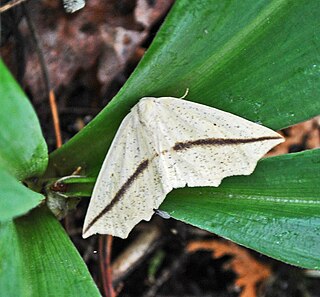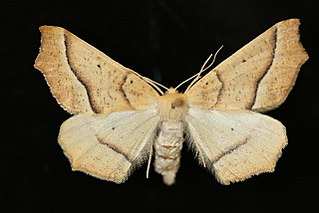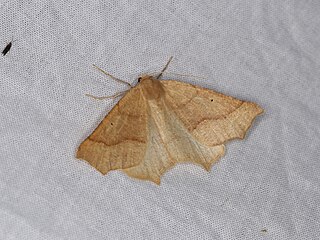
The geometer moths are moths belonging to the family Geometridae of the insect order Lepidoptera, the moths and butterflies. Their scientific name derives from the Ancient Greek geo γεω, and metron μέτρον "measure" in reference to the way their larvae, or inchworms, appear to measure the earth as they move along in a looping fashion. A very large family, it has around 23,000 species of moths described, and over 1400 species from six subfamilies indigenous to North America alone. A well-known member is the peppered moth, Biston betularia, which has been subject of numerous studies in population genetics. Several other geometer moths are notorious pests.

Tetracis is a genus of moths in the family Geometridae erected by Achille Guenée in 1858.

Sterrhinae is a large subfamily of geometer moths with some 3,000 described species, with more than half belonging to the taxonomically difficult, very diverse genera, Idaea and Scopula. This subfamily was described by Edward Meyrick in 1892. They are the most diverse in the tropics with the number of species decreasing with increasing latitude and elevation.

Tetracis crocallata is a moth of the family Geometridae first described by Achille Guenée in 1858. It is found in North America from Nova Scotia, New Brunswick, southern Manitoba and southern Saskatchewan to Alberta, south to northern Florida, west to Kansas, Nebraska, North Dakota and extreme eastern Texas.
Tetracis australis is a moth of the family Geometridae. It is found from the coastal southern regions of the U.S. state of California from Monterey County south to Los Encinas, San Pedro Martir, Baja California, Mexico, at altitudes from near sea level to 2,135 meters.

Tetracis cachexiata, the white slant-line or white slaut, is a moth of the family Geometridae. The species was first described by Achille Guenée in 1858. It is found in North America from Nova Scotia to central British Columbia, south to northern Florida and west to Montana and northern Colorado.

Tetracis cervinaria is a moth of the family Geometridae first described by Alpheus Spring Packard in 1871. It is found in North America from British Columbia south to Kern County, California and eastward to western Montana, south-eastern Idaho, Carbon County, Wyoming and Larimer County, Colorado. It is found at elevations of 790 to 2,375 meters.
Tetracis fuscata is a moth of the family Geometridae first described by George Duryea Hulst in 1898. It is only known from the US states of Colorado and Wyoming.

Tetracis pallulata is a moth of the family Geometridae first described by George Duryea Hulst in 1887. It is found in western North America from southern California north to British Columbia, east to Idaho and western Montana from near sea level to 2,200 meters.
Tetracis jubararia is a moth of the family Geometridae. It is found in North America.
Tetracis montanaria is a moth of the family Geometridae. It is only known from south-eastern Arizona. It is found in aspen-coniferous forests on altitudes between 2,440 and 2,715 meters.
Tetracis barnesii is a moth of the family Geometridae. It is found from the high-desert riparian canyons in Colorado and Utah to the dry coniferous forest in Oregon on altitudes between 1,555 and 1,905 meters.
Tetracis formosa is a moth of the family Geometridae first described by George Duryea Hulst in 1896. It is found in North America from Colorado, eastern Utah and eastern Wyoming west to California and north to southern British Columbia and southern Alberta at elevations between 870 and 2,320 meters.

Tetracis hirsutaria is a moth of the family Geometridae first described by William Barnes and James Halliday McDunnough in 1913. It is found in the United States in California and extreme southern Nevada.
Tetracis pallidata is a moth of the family Geometridae first described by Clifford D. Ferris in 2009. It is found in British Columbia, Idaho and Washington.
Louis Beethoven Prout (1864–1943) was an English entomologist and musicologist.
9,9'-dicis-zeta-carotene desaturase is an enzyme with systematic name 9,9'-dicis-zeta-corotene:quinone oxidoreductase. This enzyme catalyses the following chemical reaction
William Warren was an English entomologist who specialised in Lepidoptera.
Prolycopene isomerase is an enzyme with systematic name 7,9,7',9'-tetracis-lycopene cis-trans-isomerase. This enzyme catalyses the following chemical reaction
This page is based on this
Wikipedia article Text is available under the
CC BY-SA 4.0 license; additional terms may apply.
Images, videos and audio are available under their respective licenses.







